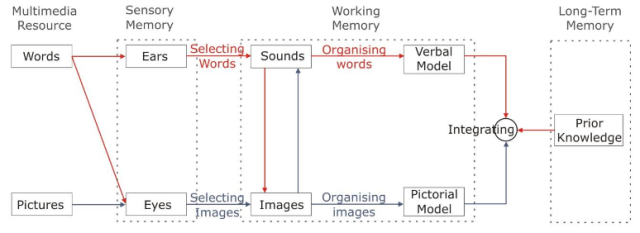Applications that combine different mediums (sound, text, still images, graphics, animations, videos, etc.) belong to the wide area of Multimedia.
The basic characteristics of a digital multimedia application are that is computer controlled, is integrated in an environment, delivers digital information representations and has an interactive interface.
Through a multimedia interface we can control how learners perceive information, how learners communicate with the environment, how learners move/navigate from one part of the information to another and how learners interact/control the activities by means of icons and/or windows.
Teachers have the opportunity to combine text, sound, graphics, video and animation in order to deliver visual and/or verbal information to their students facilitating their learning.
Thus teachers use
- text in order to provide the important information on screen, to convey ideas and give the opportunity of interaction inside the application;
- sound in order to present more verbal information to students (short instructions, narration of text content) or to have sound effects;
- graphics (e.g., images, drawings, graphs from a spreadsheet, scanned images) in order to visualise concepts, develop an effective visual communication and conceptual ideas;
- video in order to provide more information than text, graphic, and to describe experience enhancing students’ reflection on what they are doing; and
- animation in order to illustrate the changes in state over time of a drawn (or simulated) object.
Through multimedia applications abstract concepts, phenomena and/or learning situations are explained to students in order to assist them to obtain knowledge and/or skills on a cognitive topic. However, as multimedia applications mediate between teaching and learning, psychological principles and aspects should be taken into account for their design.
According to Mayer & Moreno (2002; 2003) (cognitive multimedia load theory), there are three levels of cognitive load processes which are involved in multimedia learning:
- selection: verbal and visual information are selected by two separate but interrelated memory channels (verbal and visual channels);
- organisation: learners organise incoming words into a coherent verbal representation and images into visual representation; and
- integration: learners integrate these two types of representations with relevant prior knowledge.

Mayer and Moreno’s schema for the processing of knowledge from a multimedia resource (Mayer & Moreno, 2003)
Thus a learning developer should take into account the working memory’s function (limited capacity, intrinsic load, extraneous load and germane load) split-effect and modality effect in order to develop an effective multimedia application (Limniou, 2012).
Virtual Reality (VR) is an extension of interactive multimedia where the basic multimedia elements of imagery, sound and animation applied to computer-simulated environment. VR applications simulate the physical presence in places in the real world or in imaginary worlds which are rendered in a computer screen or special stereoscopic displays such as the immersive Head Mounded Display (HMD) and the immersive projects technology systems (IPT) and by wearing stereo shutter glasses the users have the feeling of three-dimensional (3D) environment. Comparison between the 3D and 2D animations for educational purpose showed that by using VR capabilities students could better comprehend the topic, as any limitation of human vision has been overcome and virtual objects are perceived as real (Limniou, Roberts and Papadopoulos, 2008).
References
Mayer, R.E., & Moreno, R. (2002). Aids to computers-based multimedia learning.Learning and Instruction, 12(1), 107–119.
Mayer, R.E., & Moreno, R. (2003). Nine Ways to Reduce Cognitive Load in Multimedia Learning. Educational Psychologist, 38(1), 43–52.
Limniou, M., Roberts, D. & Papadopoulos, N. (2008). Full immersive virtual environment CAVETM in chemistry education. Computers & education, 51(2), 584–593.
Limniou, M. (2012). From present to virtual classroom: A review of the influence of ICT on education. In S. Abramovich (Ed), Computers in Education, New York:NOVA Science Publishers ISBN: 978-1-62100-621-3, pp. 93-119.

Multimedia by Maria Limniou is licensed under a Creative Commons Attribution-NonCommercial-ShareAlike 3.0 Unported License.